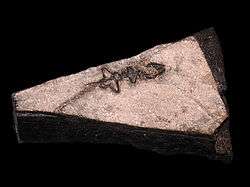Diphydontosaurus
| Diphydontosaurus Temporal range: Late Triassic, 231–200 Ma | |
|---|---|
 | |
| Fossil in Museo civico di scienze naturali di Bergamo | |
| Scientific classification | |
| Kingdom: | Animalia |
| Phylum: | Chordata |
| Class: | Reptilia |
| Order: | Rhynchocephalia |
| Suborder: | Sphenodontia |
| Genus: | †Diphydontosaurus Whiteside, 1986 |
| Species: | †D. avonis |
| Binomial name | |
| Diphydontosaurus avonis Whiteside, 1986 | |
Diphydontosaurus was a sphenodontian reptile from the Late Triassic of England and Italy. This small animal was related to the living tuatara (Sphenodon). Diphydontosaurus may have hunted and eaten insects in the crevices of ancient caves using its claws. It may have grown to a length of 4 inches (10 cm). It is a rhynchocephalian more derived than Gephyrosaurus, yet more primitive than Planocephalosaurus, and shares traits with both of them.
Description
Diphydontosaurus was a small sphenodontian, measuring up to 10 cm (4 in) long. It had long, sharp claws to help it catch its prey,[1] and peg-like piercing teeth to help it eat insects. These features are shared with the other primitive rhynchocephalians Gephyrosaurus and Planocephalosaurus.[2]
Classification
Diphydontosaurus is known from many mostly complete specimens,[1] which means that its classification as a rhynchocephalian is quite certain. In an analysis by Oliver Rahut and colleagues in 2012, it was found that Diphydontosaurus is the second most basal rhynchocephalian, after Gephyrosaurus, and the most primitive sphenodontian, more primitive than Planocephalosaurus. Their analysis is shown below:[2]
| Rhynchocephalia |
| |||||||||||||||||||||||||||||||||||||||||||||||||||||||||||||||||||||||||||||||||||||||||||||||||||||||||
| |
Paleoecology
Diphydontosaurus was a small animal that lived in the Bristol Channel region of England, and Italy. In the Bristol Channel, it lived during the Triassic about 205 mya. The deposits in which it is from are complete enough for its ecosystem to be reconstructed in 2012. In the Late Triassic, the regions that Diphydontosaurus lived in were numerous rocky, small caves, that sat on a limestone bed. It is likely that the caves were eroded by possibly acidic rainwater. Diphydontosaurus is very well known from these deposits, potentially because they drowned after a rainstorm or monsoon. Other animals also found in the caves were 2.97 m (9.75 ft) long sauropodomorph dinosaurs, smaller 10 cm (4 in) sphenodontians like Diphydontosaurus, and other groups of varying sizes between the two. In the cavernous system, the small sphenodontians like Diphydontosaurus probably fed on intsects.[1] Diphydontosaurus existed from 231–200 mya in both England and Italy combined.[2]
References
Footnotes
- 1 2 3 Benson et al. 2012, pp. 208–209.
- 1 2 3 Rahut et al. 2012.
Citations
- Benson, R.; Brusatte, S.; Hone, D.; Naish, D.; Xu, X.; Anderson, J.; Clack, J.; Duffin, C.; Milner, A.; Parsons, K.; Prothero, D.; Johanson, Z.; Dennis-Bryan, K. (2012) [2009]. Ambrose, Jamie; Gilpin, David; Hirani, Salima; Jackson, Tom; Joyce, Nathan; Maiklem, Lara; Marriott, Emma; Nottage, Claire; van Zyl, Meizan, eds. Prehistoric Life: A Definitive Visual History of Life on Earth. Dorling Kindersley. pp. 1–512. ISBN 978-0-7566-9910-9. OCLC 444710202.
- Rauhut, O. W. M.; Heyng, A. M.; López-Arbarello, A.; Hecker, A. (2012). "A new rhynchocephalian from the Late Jurassic of Germany with a dentition that is unique amongst tetrapods". PLoS ONE. 7 (10): e46839. doi:10.1371/journal.pone.0046839.
- Whiteside DI (1986). "The head skeleton of the Rhaetian sphenodontid Diphydontosaurus avonis gen. et sp. nov., and the modernising of a living fossil". Philosophical Transactions of the Royal Society B. 312 (1156): 379–430. doi:10.1098/rstb.1986.0014.
- Jones MEH. 2008. Skull shape and feeding strategy in Sphenodon and other Rhynchocephalia (Diapsida: Lepidosauria). Journal of Morphology. 269: 945–966. doi:10.1002/jmor.10634
- Whiteside DI, Marshall JEA. 2008. The age, fauna and palaeoenvironment of the Late Triassic fissure deposits of Tytherington, South Gloucestershire, UK. Geological Magazine 145:105–147. doi:10.1017/S0016756807003925